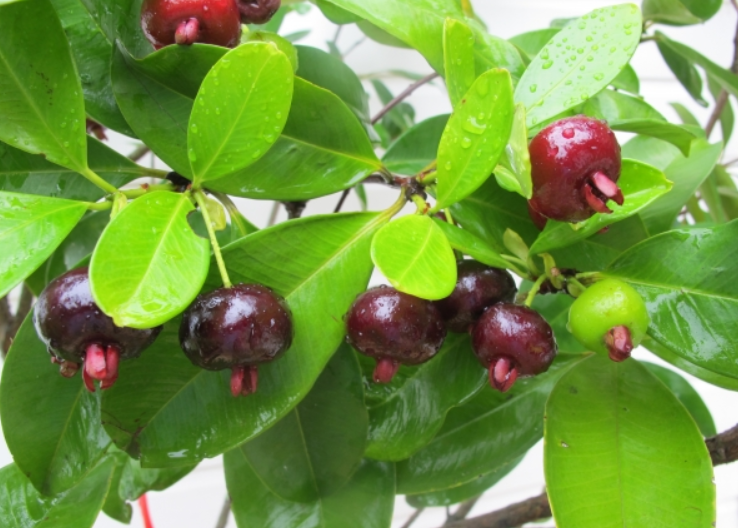The wet summer season in the subtropics is a time for lush grass, sunshine, Christmas holidays and vigorous plant growth. So what better time to investigate some new and interesting fruit trees for your orchard? The traditional fruit trees that require a cold snap to set fruit are never going to be winners in the sub tropics. Cherries, olives, & apples, for example, will always struggle with the heat and humidity, but there are lots of exotic fruit trees that will thrive in our harsh summer. Here are just 10 of the many unusual fruit trees that suit the subtropics.

Grumichama – also called the Brazilian cherry, this is a medium-size tree native to Brazil. It can easily grow to 10 metres tall and prefers to be in the ground rather than a pot. Small cherry-like fruits are produced after around 4 years growth, whose taste is often likened to that of a sweet plum. It is sometimes said to be a cherry for the tropics. The fruit makes an excellent jam, and suffers little pest damage. Grumichama trees require moderate rainfall and will tolerate light frosts. The yellow-fruiting variety is less common. Our detailed article has more photos and info about growing grumichamas.

Cedar bay cherry – also called beach cherry, the cedar bay cherry is an Australian native shrub from North Queensland with a sweet fruit about the size of a jaboticaba. While they are slow-growing (ideal for pots!), they will fruit in their first or second year. They have the potential to grow up to 1.5 metres (4 foot) high, and are best suited to dappled light. Fruit may vary considerably in size, taste and colour.

Achacha – A highly prized fruit from the Amazon basin. Reputed to have a unique taste that has a balance of sweetness and acidity. A moderate size tree that can grow to 10 metres, the achacha prefers full sun and will fruit in summer at around 5 years old. The worlds first commercial achacha plantation began in North Queensland in 2003.

Guabiju – Another Brazilian native with a unique fruit. The brown skin contains a gelatinous orange flesh said to taste like sugary creme brulee. Best grown in part shade with good drainage, this tree can grow to 10 metres or more in the right conditions. It has a semi-deciduous habit and may develop an interesting twisted and gnarly trunk with age. Guabiju trees are slow growing in the first year but the growth rate will increase with time. They should fruit after 3-4 years.

Black sapote – also called chocolate pudding fruit. Native to Mexico, this is a beautiful evergreen fruit tree with shiny dark green foliage. You can see what they (and other exotic fruit trees) look like here in our video tour. The black sapote is exceptionally hardy and can survive drought and harsh conditions but will not tolerate frost. The tree grows to five or six metres high but can be kept trimmed to your desired height. The spread is quite wide so you will need a fairly large yard if you plan on growing one of these in the ground. You can save the seed and grow them yourself, as they grow true to type. Pick the fruit when the crown of the fruit turns upwards Will fruit in around 5 years.

Jaboticaba – One of the most ornamental fruit trees, as it fruits on the trunk. This Brazilian native has several varieties, including a large fruited, yellow, small leaf, red hybrid and dwarf. The taste of the fruit is likened to that of a grape. A medium sized tree to 12 metres, it can be grown in pots. The jaboticaba is generally slow growing and you can expect several crops per year after approximately 5 years.

Kwai muk – This Chinese native is a slender slow-growing small evergreen tree. It has a dense rounded canopy and will grow 6-8 metres tall. The fruit is said to have an unusual citrus flavour. Kwai muk can be propagated by seed.

Panama berry – A fast-growing and highly ornamental tree that produces small red berries which are renowned for their sweet caramel and fairy floss taste. The panama berry can grow to 10 metres in the ground but can be contained to a large pot if it is pruned regularly. The panama berry tree will fruit after 2 or 3 years, and will then crop throughout the year.

Ice cream bean – This large leguminous tree can reach a height of 17 metres, so position it carefully. The large pods have inedible black seeds which contain a white cottony pulp said to taste like vanilla ice cream. It requires full sun and well-drained soil. Despite its potential size, it can be grown in a pot with regular pruning. As a legume, the ice cream bean tree will never need added nitrogen; as with all beans, it is a nitrogen-fixer.

Pitomba – An attractive small evergreen tree native to Brazil, that produces small fruit with a taste somewhat like an apricot. The pitomba is a slow-growing tree well-suited to growing in pots. With the right conditions, it can grow to a maximum height of 5 metres if planted in the ground.
These are just a few of the hundreds of exotic and unusual fruit trees for the sub tropics. They’re not as easy to find, but are well worth the effort. Check your local facebook groups or have a browse through daleysfruit.com.au, a specialist subtropical fruit tree nursery that sells online. Happy gardening!











